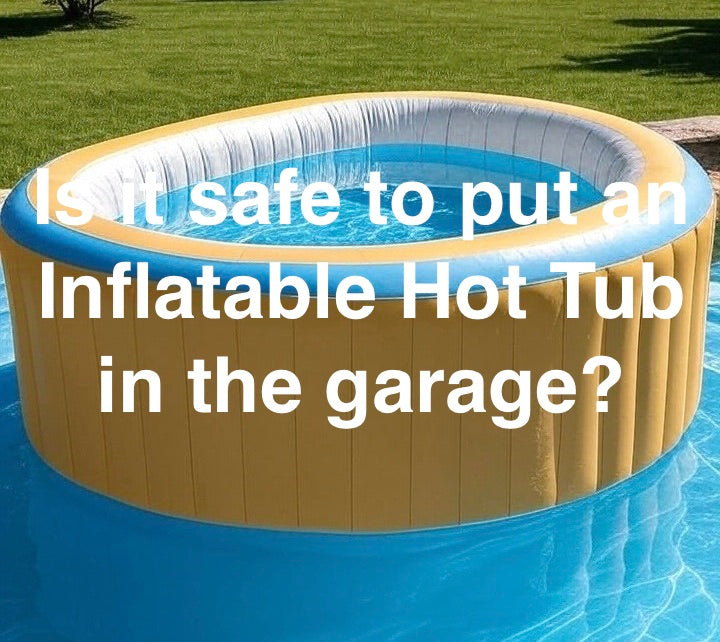
Is an Inflatable Hot Tub in the Garage Safe?
Ever looked at your chilly garden in winter and thought, “Wouldn’t it be easier to just stick the hot tub in the garage?” You’re not alone. The idea of a snug, all-weather soak just a few steps from the house is tempting.
Short answer: yes, inflatable spas can go in the garage — but only if you set things up properly. Without care, you’re risking damp walls, dodgy electrics, and a lot of stress. With the right prep though, it can be a safe, cosy family retreat.

Addressing the Key Safety and Practical Considerations
Ventilation and Humidity Control
The biggest issue indoors? Moisture. A steaming tub in an enclosed space soon creates mould and mildew. Left unchecked, that musty smell spreads — and no one wants their garage smelling like a damp towel.
The fix is airflow. Crack open windows, fit an exhaust fan, or simply roll the garage door up when it’s in use. A dehumidifier can also work wonders in keeping humidity down. And don’t forget a good hot tub cover when it’s not bubbling away — it traps steam and protects your spa.
Electrical Safety
Water and electrics are a dangerous duo. Your inflatable hot tub will need a proper, dedicated power supply — ideally on its own GFCI-protected circuit. It’s one of those jobs where calling in a qualified electrician is well worth the peace of mind.
And whatever you do, avoid extension leads. They’re not designed for hot tubs, and the risk of overheating or shocks just isn’t worth it.
Flooring and Structural Support
A full inflatable spa is heavy — we’re talking hundreds of kilos of water plus a few adults enjoying a soak. Most garage floors are concrete, which is ideal, but you’ll still want to check for cracks or uneven patches.
Lay down a ground cloth or protective mat to stop punctures. For extra safety, consider slip-resistant flooring like rubber mats or interlocking tiles — wet feet and smooth concrete aren’t the best combo.
Water Management and Drainage
Splashes happen — especially if the kids are involved. Ideally, a garage with a floor drain or gentle slope makes life easier. If you don’t have one, keep a wet-vac or a stack of towels handy for the inevitable puddles.
And remember, hot tubs need a full drain and refill every couple of months. Plan ahead for where all that water is going to go — a small pump can help shift it to an outside drain.
How to Set Up Your Inflatable Hot Tub in the Garage
Site Preparation
Start with a clear, clean floor. Sweep up grit, check for sharp objects, and make sure the surface is level. Measure twice to be sure the spa fits with space around it for safe entry and easy maintenance.
Think about how you’ll move around the tub too — squeezing sideways against a wall to climb in isn’t exactly the spa vibe you’re going for.
Assembly and Filling
Once your site’s ready, lay down your protective mat or ground cloth. Inflate the tub, connect the pump unit securely, and start filling.
Keep an eye on the hose and connections — it’s easier to fix a drip now than after the spa is full.
Maintaining Your Garage Hot Tub for Long-Term Safety

Regular Water Chemistry
Even in a garage, water care is non-negotiable. Test and balance the pH, alkalinity, and sanitiser levels regularly using strips or kits.
Ignore it, and you’ll quickly face cloudy water, irritated skin, or worse — bacteria growth. Staying on top of the chemistry keeps soaks safe and stress-free.
Cleaning and Care
Filters are the unsung heroes of your spa. Rinse or replace them weekly, and give the liner a regular wipe-down. Plan to change the water every one to three months depending on use.
A little cleaning routine goes a long way towards keeping your garage spa fresh.
Year-Round Operation and Storage
Thinking of using your tub in winter? If your garage isn’t heated, look for models with “freeze shield” technology to stop water freezing in the pipes.
Not planning to use it year-round? Drain, clean, and dry the spa properly before packing it away. Store it in a cool, dry spot until the next soak season.
Key Takeaways
-
Yes, inflatable spas can go in the garage — but only with proper planning.
-
Good ventilation and humidity control prevent mould and mildew.
-
A dedicated, GFCI-protected circuit is essential for safe electrics.
-
Strong, level flooring and slip-resistant mats keep the spa stable and safe.
-
Plan ahead for water management — splashes, spills, and full drains.
-
Regular cleaning, water chemistry, and filter care keep everything hygienic.
-
In cold garages, choose freeze-protected spas or pack away for the season.
Conclusion
So, is a garage a safe home for your inflatable spa? Yes — as long as you plan ahead. Ventilation, flooring, electrics, and water management all need some thought. Skip those, and you’re heading for damp walls, high bills, and potential hazards.
Get it right, though, and you’ve got yourself a snug little family hideout. A warm soak without battling the British weather? Now that sounds like a win.
Have you checked out our other posts?
Can You Put An Inflatable Spa On A Deck?
Do I Need To Put Anything Under An Inflatable Hot Tub?
Can A Balcony Hold An Inflatable Hot Tub?
Can An Inflatable Hot Tub Be In The Sun?
Where Is The Best Place To Put An Inflatable Hot Tub?
What Is The Best Thing To Put An Inflatable Hot Tub On?



Leave a comment